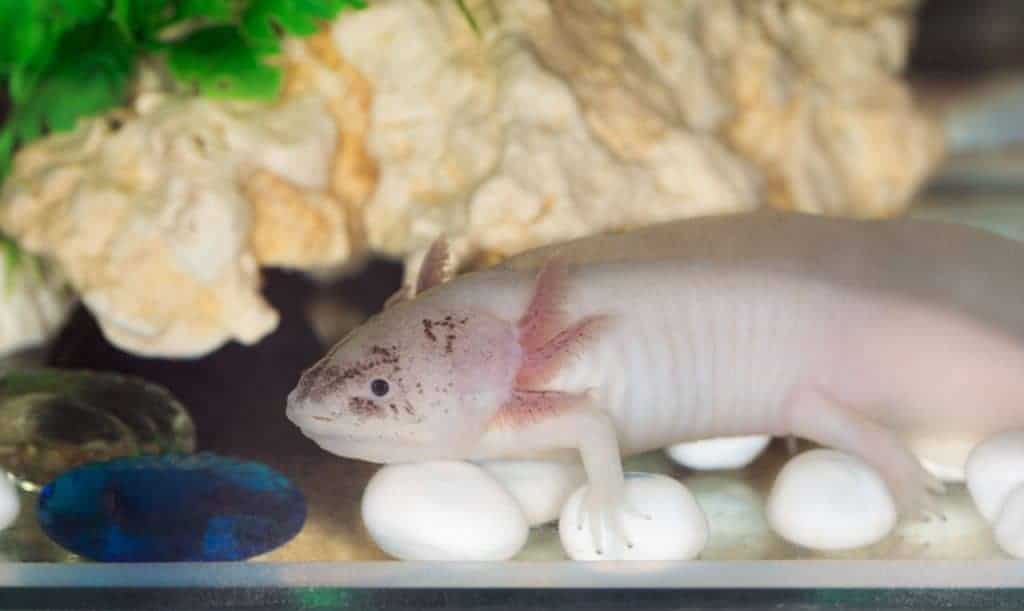How Much do Axolotls Cost? What about the Accessories?
Axolotls are amazing creatures and owning one is such a privilege. But before anyone buys one, they need to know how much they cost up front, in the long run, and what the additional cost of the accessories is going to be. With this in mind, I did some more research on Axolotls and found out everything you’ll need to know about buying one.
How much does it cost to own an Axolotl?
Axolotls are inexpensive pets. Buying an Axolotl baby costs about $20 and an adult costs $35. The real expense is the tank and accessories needed to house your axolotl, which can range from $85- $285.
So if you are interested in owning a Mexican Walking Fish and having them all to yourself, then read this post because it has all the information that future owners could need about owning an Axolotl and how much that costs.
What are the Base Costs for Owning an Axolotl?
Fun Fact: Although Axolotls are rather inexpensive pets and they are bred quite rapidly in captivity, Axolotls are actually critically endangered because of the pollution of their natural habitat and the introduction of foreign species to their natural environment.
Before buying any type of pet, amphibian, or animal, it is important to know how much work and effort goes into providing for and caring for one of these animals.
It is also important to know why things cost the price that they do. This comes in handy when talking about Axolotls and the costs of living with such a unique and proud amphibian.
When purchasing an Axolotl from a breeder or from a pet store they will normally cost about 20 dollars as juveniles but they go up in price to about 35 dollars once they have become adults.
Keep in mind that the cost of an axolotl is higher for albino axolotls, melanoid axolotls, leucistic or piebald axolotls, a chimera or golden albino, or another interesting morph axolotls. An animal with a pure white albino coloring or a copper sheen can reach very high prices.
The initial cost is higher for these axolotls, and there’s often a live arrival guarantee since you’re making such a significant investment. These individuals may be shipped all over the United States, from California to New Jersey, so a health guarantee is a good idea.
The price for an actual Axolotl is rather low, but the price to house this unique amphibian can get a little expensive depending on what you are looking for in terms of housing. The axolotl tank, aquarium sand, filtration systems, and other equipment goes into the average cost of an axolotl.
A basic starting kit that has a filter pump, gravel, and a pH kit will normally cost about 85 dollars. The thing to remember though is that the higher quality the filter the less often you have to clean the aquarium.
Because of that, it is normally recommended to get a higher quality filter and pump. They normally cost around 165 dollars, but it really is worth it. A fungal infection can quickly kill your pet, and any chlorine or salt in the water can be devastating as well.
Each time you clean your Axolotl’s cage the new water has to be prepared and tested before it is added to your Axolotl’s water or it could negatively affect the environment and you Axolotl could get sick and possibly could die.
So, having a strong filter not only saves you work but it is actually better for the long term health of your Axolotl. That is why most breeders and pet store owners will push you to get a nicer pump.
When it comes to gravel and accessories, be careful. Axolotls can only have specific types of gravel and plants in its habitat, so it is important to do your research before spending a lot of money on accessories and rocks that won’t even work in your cage.
The other big expense that you have to add into the first time buy category is a tank. If you have only one Axolotl then your tank only needs to be around 15-20 gallons.
If you are housing two Axolotls then it is recommended to double the tank size and to provide to separate enclosures so that the two Axolotls can get away from each other and each have a place to call his own. Although, you can have two Axolotls in a 20-gallon tank.
A new tank will cost anywhere from 70 dollars to 120 dollars depending on the type of tank that you want to buy and what comes with it. Most tanks are around 90 dollars.
While most people look at the base amount of money that it requires to purchase an Axolotl and put that as the price of cost for the pet, there is still a lot more money factors that come into play when purchasing an Axolotl and any pet.
So while an Axolotl may cost $20 you also have to factor in the price of housing the salamander, the accessories needed, the cost of maintenance, the cost of food, and whether or not these added costs are worth owning the pet.
Fun Fact: Although the Axolotl is rather sensitive, if they do get hurt they have the amazing power of regeneration. They can regenerate any limb multiple times as well as their gills, essential organs, and brain.
What Accessories are Needed When Owning an Axolotl and What Costs Do They Add On?
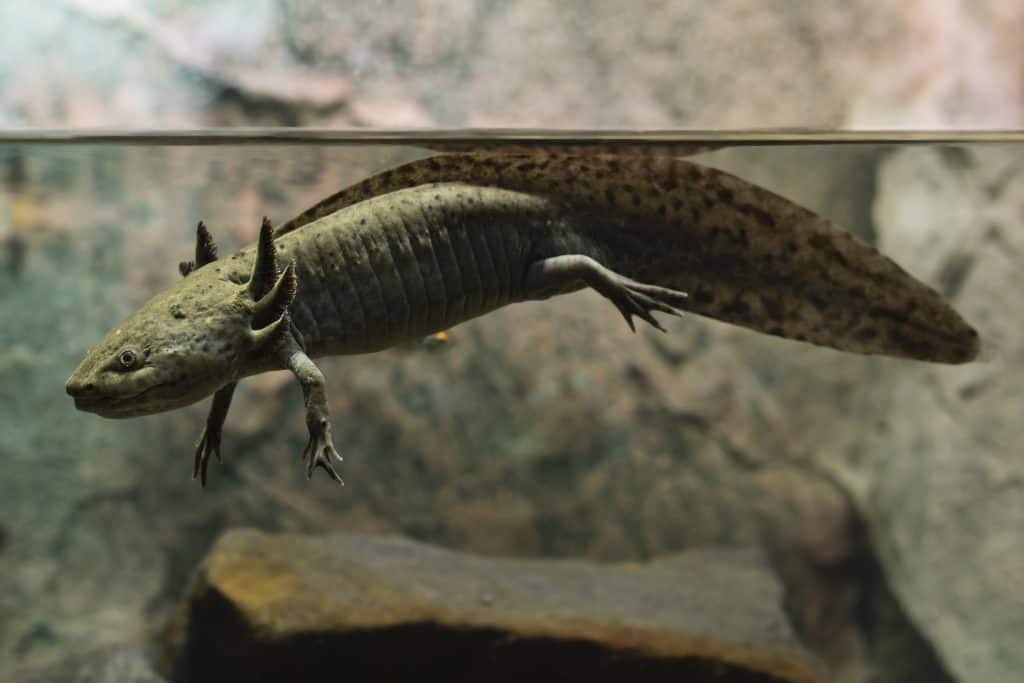
Let’s talk accessories. As any female will admit accessories can make or break an outfit, and the same applies for Axolotls and their tanks. If it seems completely unnecessary than it probably is and you don’t need it.
Axolotls are interesting creatures and they have very specific needs as well as very specific things that cannot be used inside their houses. Because of their inquisitive natures and their sensitive skin, these little guys need to have the perfect environment to live in.
So the first thing that you need is a tank, and really it doesn’t need to be anything special. You can get some really nice high-quality tanks on Amazon for great prices that will last forever.
Once you have a tank in place the next thing that you need is gravel or sand. Although, sand is preferred over gravel. If you choose to use gravel in an Axolotl’s tank, it is one of those things that is super duper specific.
Fun Fact: In the wild, the Axolotls can only be found in one place. They live in Lake Xochimilco and its surrounding canals. So, their home environment is very specific and they are bred to live in those conditions.
The gravel needs to be rough and large enough that it can’t be easily swallowed by an Axolotl. Because Axolotls are curious and they aren’t used to small pebbles in their natural environment they will eat anything smooth and small enough.
But don’t be fooled by the smooth factor, even if you fill your tank with rough pebbles that are on the small side your Axolotl will still try to eat them.
If an Axolotl does eat the pebbles and gravel provided for them as a part of their aquarium it will cause serious abdominal problems and cause health issues that can only be resolved with a vet. That is why it is imperative to make sure you get the right kind of gravel.
Something like turtle gravel would work nicely and keep your Axolotl from getting into trouble where unnecessary eating is concerned. You can also use river rocks to give it a nice look but make sure that they are rough enough and big enough so that they will also be safe.
When in doubt buy something bigger. It is way better to be safe than sorry. Nobody wants to have to take their pet to the vet, so pick out large enough rock sizes.
Sometimes putting larger stones on top of gravel that may seem on the verge can dissuade them from eating them, but not always.
Layered on top of your pebbles like mentioned before or laid out on the sand or the bare glass floor of the tank could be some larger rocks to add a variety for your Axolotl.
They are not required but they can be nice and as mentioned can sometimes dissuade from the attempted eating of the smaller pebbles.
If you find that anything you have set up in your aquarium is causing cuts or harm to your Axolotl then you may want to consider replacing it. Sometimes it can just be an accident, so wait for two or three incidents before replacing the material.
Sand is the preferred method for Axolotls because they won’t try to ingest it and if they do it wouldn’t hurt them. Really any type of sand will do as long as it is fine sand and is meant for aquarium use.
You can still place larger rocks on top of the sand if you want to add some textures for your Axolotl, but it is not necessary. If you do choose to use larger rocks just make sure that they aren’t a swallowable size.
The next accessory that is needed in an Axolotl’s aquarium is a place for it to hide or hang out. A small clay flower pot turned on its side works great, or if you want something fancier you can purchase an aquarium castle.
Other than that plants are really the only other thing that could be placed inside an Axolotl’s aquarium. When looking at plants you want to make sure you are careful to get the right kind so that they don’t harm your Axolotl.
Just make sure that they aren’t sharp on the edges and that they can’t easily be pulled apart and digested. If your plants fit that bill then they will be just fine to use in your aquarium.
Axolotls love plants and they love to hide among them. Silk plants or real plants are the best options. Staying away from sharper plastic plants is a wise idea.
Costs to Set Up an Aquarium and its Accessories for an Axolotl
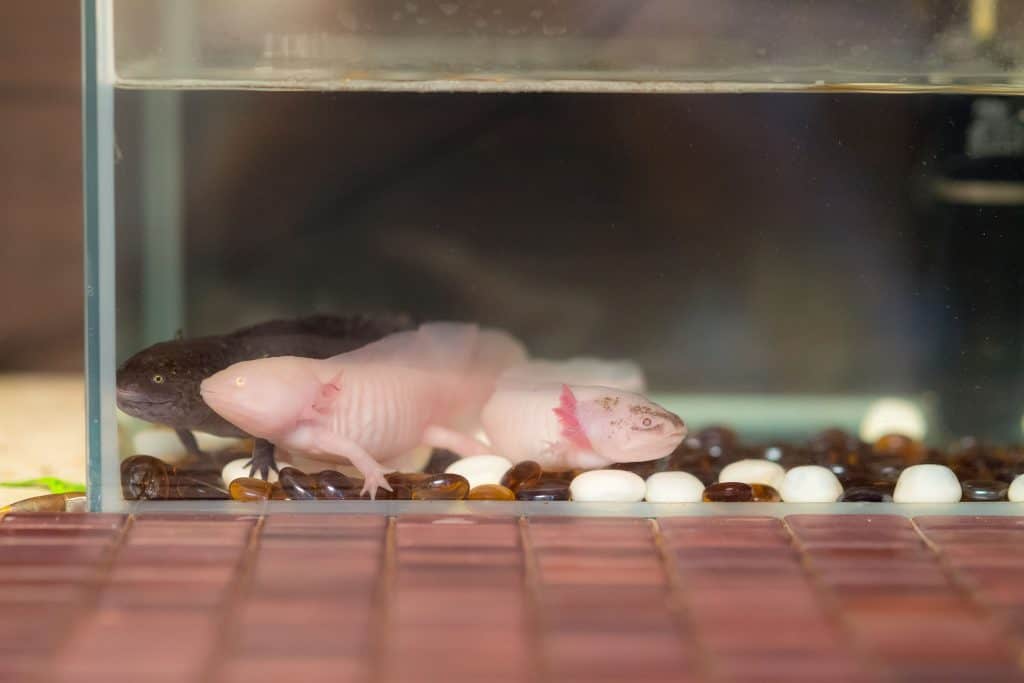
Setting up your aquarium for your Axolotl sounds a little complicated, but it’s not that bad and it is fairly easy to maintain after it has been set up properly.
The first thing that you have to do is add water. You can add as much water as you like whether that is a couple of inches high or completely full. Tanks tend to be easier to maintain when they are almost full though.
Really the only requirement for water depth is that it covers your Axolotl completely and then gives a couple more inches for wiggle room.
Most tanks you see will be filled about ¾ of the way full or almost all the way full because it is far easier to maintain.
Fun Fact: In the wild Axolotls are rarely ever white, but they have gone through selective breeding in captivity to produce more and more white Axolotls.
You can use tap water for your aquarium but it should be treated with an aquarium water conditioner to remove any chemicals that would be harmful to your Axolotl.
A lot of Axolotl pet owners like to use brackish water that is part freshwater and part saltwater. This solution can be bought at any pet store and can be found online.
It is preferable to set up your tank a few weeks before you purchase your Axolotl so that the tank has a few weeks to filter through its cycle before your new Axolotl is added to the environment.
It is important to check the pH levels before you introduce your Axolotl into the new environment and also regularly when cleaning or changing your Axolotl’s water.
The pH level to strive for is 7.4 to 7.6 pH. If it is in the range of 6.5 to 8 it is probably fine, but the pH levels control the toxicity of ammonia so it is important to strive for that sweet spot of 7.4 to 7.6.
The water temperature is also important. if your water gets warmer than 74 degrees it can be potentially life-threatening to your Axolotl.
The prime water temperature is in the 60s. If you live in a warm environment and find it hard to keep your water cool you can buy a water chiller to maintain the temperature in your tank.
Once you have the water all situated, the next thing to worry about is the water filter. You want a water filter that is powerful but also one that has a slow filter flow function on it.
If the flow from the water filter is too fast it can cause harm to an Axolotl’s gills and cause them to have severe stress that can lead to death. Their natural habitat has very slow-moving water, so we have to copy that in the aquariums that we provide for them.
You also want a slow-moving filter so that your Axolotl’s gills don’t get caught inside the filter. Axolotls have gills that protrude from their heads like curly crowns and they are very sensitive.
Fun Fact: Axolotls are named after a myth that says that they originated from a god with a dog head who refused to sacrifice himself and was then cursed to live as an Axolotl which literally means water dog.
The last thing to worry about is lighting. Axolotls love dark lighting because in the wild they live mainly on the lake bottom and as such have very little exposure to light.
Axolotls can get used to light exposure but it really should never be direct light whether it be sunlight or artificial lighting because it can cause them to have stress which will normally cause them to stop eating.
It is best to put them in a darker room that is far away from windows and lights like lamps. That being said your Axolotl does not need to be in complete darkness, they definitely adjust to light just not close light.
So basically don’t stick their tank in a window on directly under a desk lamp, or any lamp really. If you stay away from those things your Axolotl is sure to be healthy and strong.
The Personal Cost to Clean Your Axolotl’s Aquarium and Accessories
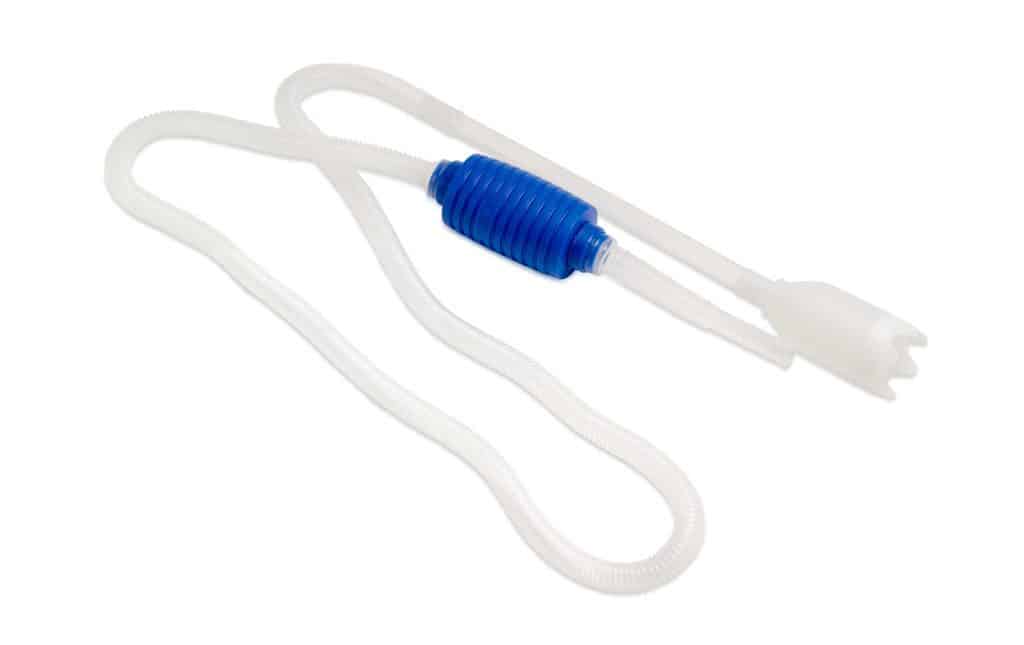
Cleaning your aquarium can seem like a daunting task, but don’t worry, it is definitely easier than it seems. Especially when you have done it once or twice and you have gotten a good rhythm down.
The first thing to know when you are taking care of an Axolotl and their environment is that you should never replace the water completely all at once… EVER.
Whenever you clean and replace water make sure that you are replacing 20 percent of the water per cleaning.
In order to make the process of cleaning your aquarium easier and faster, try using a siphon to vacuum the bottom of the tank because it really helps. This cleaning and water changing process should be done weekly if you have a good filter and daily if you do not have a filter or one that is not very powerful.
Remember to treat the new water with a water conditioner before placing it in the tank to remove any harmful substances. P.S. Always check the aquariums pH levels a few minutes after you add in the new and conditioned water.
When you are cleaning with a siphon or a gravel vacuum, the best way to clean your tank is to start by gently running your siphon over the gravel/sand bed and lightly get up all of the top layers of dirt and fish feces and then go back over and press into the gravel/dirt so that the flooring is properly cleaned.
When you are cleaning the filter and the rocks and other materials that may be placed inside your aquarium, it is very important that you clean them with tank water so that they aren’t introduced to outside chemicals that could potentially harm the tank cycles that have been created and your Axolotl.
Be especially careful when rinsing out and cleaning your filter. There are a lot of good bacteria that build up inside your filter and are helpful in keeping your Axolotl alive. For this reason, never clean out your filter with tap water. Only use tank water.
How Much Does it Cost to Feed an Axolotl?
In the wild Axolotls eat a diet that consists of some small fish but is mainly supplemented with worms, mollusks, insect larvae, and crustaceans. These helpful little critters keep the Axolotl alive.
In captivity, an Axolotl’s diet has to be a little bit different than it is in the wild. Still, it is our job to feed them foods that are similar to their natural prey. That way we know they are getting the nutrients they need, and they like them.
In captivity, it is common to feed Axolotl earthworms because they are the healthiest choice for them, but eating bloodworms or blackworms can also be a great nutritional choice for your Axolotl.
Earthworms when bought in bulk generally cost about $30 per pound which is a nice price considering that you get around 400 worms per pound. That means that you are paying a little less than 10 cents per worm.
So feeding Axolotl earthworms is pretty inexpensive, but it can get expensive if you buy the worms locally. Normally fish shops will sell earthworms for around 2 or 3 dollars per dozen. That means your paying 20 cents per worm which can get expensive.
Bloodworms and Blackworms are a lot more expensive than earthworms. Bloodworms cost about $8 per dozen and blackworms cost about $50-$60 per pound.
So if you choose to feed them either of those two worms then you will have to bump up your budget for food meaning that your Axolotl will end up costing more.
There are also certain treats that you can feed Axolotls occasionally that can bump up your food costs. Like:
- frozen Shrimp (that are already cooked) ($6 for 12oz)
- Prawns ($30 per pound)
- Mealworms ($13 per 1000)
If you really want to go all out you could feed them some
- Lean Chicken ($9 per pound)
- Lean Beef ($10 per pound)
- Fresh Tuna ($30 for 6oz)
It is nice to know that like other salamanders, Axolotls do not need any extra supplication of vitamins or minerals. So, the basic diet that you feed them contains all of the nutrients that they need to be happy and healthy. This is nice because it means you don’t have to spend extra on supplements.
If you are wondering how often to feed your Axolotl, the basic answer is to let them decide. Most adult Axolotls will eat about two earthworms every two to three days, but if they aren’t hungry they may choose to skip a meal.
Young and growing Axolotls are quite different in the fact that they will eat daily because they need the energy to maintain their rapid growth. Once your Axolotl reaches adulthood it will be a lot easier to come up with a feeding pattern that is tailored to your specific Axolotl.
Vets Cost Money Too
Some pets require a lot of care and attention when it comes to feedings, care, love, and attention. Luckily Axolotls are pretty low maintenance. If you keep their aquarium clean and feed them they are pretty happy and comfy.
The only specific need or requirement that Axolotls may have is their vet. Because Axolotls are exotic pets, you will need a vet that is not only willing to work on them but also knows how to work on them.
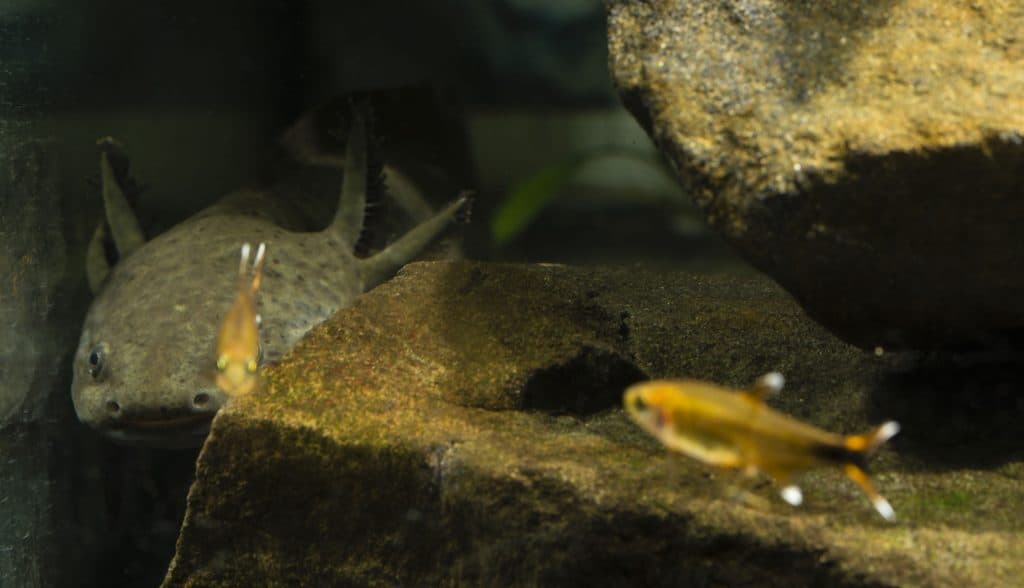
And that normally means a more expensive vet bill. While that price will vary between vets before you purchase an Axolotl you should contact vets and learn how much they will charge for seeing such an exotic pet.
Nobody wants your Axolotl to get hurt or not to get proper care, so finding them a good vet should be one of many pet owner’s first responsibilities when they own an Axolotl (and really any pet for that matter).
Fun Fact: Did you know that Axolotls are still being used in research facilities to this day because they are considered “A Model Organism”. Also, more Axolotls are bred in captivity than in the wild.
Other than vets though, Axolotl are low maintenance and very chill. They are happy to be on their own living their best lives. If you choose to have two Axolotls in one aquarium you may want to check up on them more often.
You should just check every couple of days to make sure that they haven’t been fighting and that they both seem content and happy.
This should be the case as long as provide two separate hideouts so that they can claim their own spaces and hide from each other when they don’t want to be social.
Are the Costs of Owning an Axolotls Worth Having One as a Pet?
Now that we have gone over all of the costs and nuances of taking care of our Axolotls it is important to know what it is like to live with an Axolotl as your pet. There are things you need to know about their lifestyles and how they can affect yours.
It is also important to know how they differ from other amphibians and fish that you may have previous experience with. Because Axolotls are not fish and yet they are not quite fully amphibians they kind of have taken on a class of their own.
| Axolotls | Fish | |
| Similarities | Live long lives in Aquariums Cannot survive out of water Need their tanks to be cleaned weekly Don’t need a substrate They have gills | Live long lives in Aquariums Cannot survive out of water Need their tanks to be cleaned weekly Don’t need a substrate They have gills |
| Differences | They can breathe out of water Their gills protrude from their heads They cannot live with other species of fish They eat live food They cannot live in direct sunlight They can’t have a gravel substrate Should not be handled by humans | Fish cannot breathe out of water Their gills are built into the skin at their necks They have scales They can live with multiple different species of fish (If they aren’t carnivorous) Fish can live in sunlight Fish should not eat live food. |
| Axolotls | Amphibians | |
| Similarities | Are born in water Eggs are dependant on water Have soft moist skin Live in water while babies Absorb water through their skin Cold Blooded Too much sun can damage their cells | Are born in water Eggs are dependant on water Have soft moist skin Live in water while babies Absorb water through their skin Cold Blooded Too much sun can damage their cells |
| Differences | They never go through metamorphosis They live their whole lives in water Can regenerate limbs and vital body parts (Most salamanders can do this, though not as efficiently) | Go through metamorphosis Live on the land after metamorphosis Cannot regenerate their limbs (Although salamanders can regenerate some) |
There are very few times when you should have to handle your Axolotl. They are not normal salamanders that can be held and passed from person to person. Holding an Axolotl causes them great stress.
Because of that, there are a lot of people who don’t see whether they are worth the money that it takes to house and feed them. While purchasing a pet you can’t handle for $20 seems rather inexpensive and worth it, spending $300 on it and its habitat and then having to upkeep it is not always worth the price for people.
On the other hand, if you don’t mind spending a couple of hundred dollars on a really cool and unique pet, then an Axolotl could be the perfect pet for you.
PS. In the case where you have to hold your Axolotl, whether it be to check its stomach if you think it ate something it shouldn’t have or you need to move it to a different tank while you clean because it is starting to stress out, you need to be ever so gentle and very very soft.
Fun Fact: Axolotls have virtually no true bones in their bodies. Their skeleton is made up of primarily cartilage. They have very soft bodies and permeable skin, which is why they should rarely be handled by humans.
Axolotls need a lot of support when they are handled, so their whole bodies should be supported carefully with both of your hands. Have a firm grip but don’t squeeze them. Also, you shouldn’t be alarmed if they start scratching or biting, they don’t like being handled.
Related Questions:
Are Axolotls good pets?
Owning an Axolotl is not common but it is exciting because of its exotic nature. If you want a pet that will play with you then owning an Axolotl may not be the right choice for you, but if you want an amazing pet to look after and look at this salamander may be just the pet for you.
Are Axolotls asexual?
Axolotls can be born either male or female. They reproduce by playing a little game with each other, and then the male will lead the female around while depositing sperm into the path so that the female can pick it up with her cloaca.
Do Axolotls make noise?
Axolotls very commonly will make little squeaking noises or gulping noises as they breath outside of the water. Not all Axolotls do this though, so if you feel like your Axolotl is mute don’t worry it is perfectly healthy.
Related Articles Just For You!
If you found this article about what axolotyls and how much they cost helpful, I suggest checking out one of these other articles.

